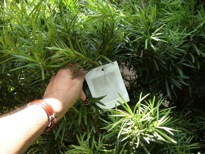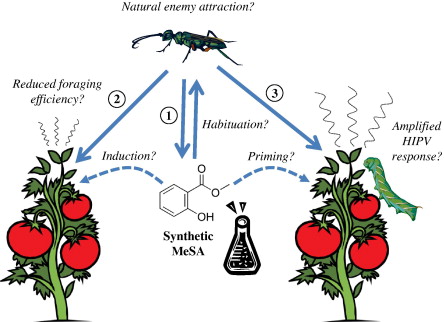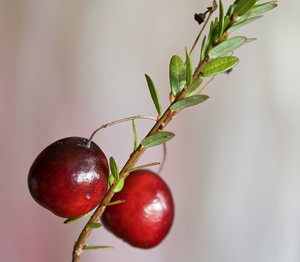An Agricultural Balancing Act: |
| Dr. Rodriguez-Saona seeks to understand these tri-trophic interactions with managed agricultural systems. He stresses that meaningful progress in pest management must include evaluation of human domestication as a factor influencing plant-mediated defense. Exploiting the availability of recently domesticated cranberry crop, its related varieties and its wildtype ancestor, Dr. Rodriguez-Saona was able to critically examine effects of domestication in a controlled setting. In a greenhouse study of five different cranberry varieties, Dr. Rodriguez-Saona applied a combination of jasmonic acid and gypsy moth caterpillars to investigate interactions between plant yield and the gypsy moth pest damage. He observed that the moth caterpillars did not perform as well on the jasmonic acid treated cranberries. This outcome was to be expected, as jasmonic acid is a signaling pathway that initiates plant defense in response to herbivore feeding. The five different cranberry varieties were then assessed for nutritional content, digestibility and HIPV production. He observed that bottom-up controls conferred through plant nutrition, digestibility, and HIPV production are altered by domestication as seen in the wild versus domesticated varieties (Rodriguez-Saona 2011b). Ultimately, bottom-up defense emanating from plants in hybridized/domesticated varieties were significantly reduced in the selection of higher yields with larger, more uniform fruit. |
 PredaLure deployed in a tree to attract natural enemies
PredaLure deployed in a tree to attract natural enemies  Possible mechanisms through which products such as Predalure, developed with synthetic MeSA, may attract natural enemies. Arrows represent the movement or attraction of the predator to the plant. Induction occurs when the plant exposed to the synthetic lure produces HIPVs. Priming occurs when neighboring plants receive a warning signal to induce volatile response. Habituation occurs when predators are over-exposed to a signal, such that the predator response is depleted (source: Kaplan 2012).
Possible mechanisms through which products such as Predalure, developed with synthetic MeSA, may attract natural enemies. Arrows represent the movement or attraction of the predator to the plant. Induction occurs when the plant exposed to the synthetic lure produces HIPVs. Priming occurs when neighboring plants receive a warning signal to induce volatile response. Habituation occurs when predators are over-exposed to a signal, such that the predator response is depleted (source: Kaplan 2012). Kaplan, I. 2012. Attracting carnivorous arthropods with plant volatiles: The future of biocontrol or playing with fire? Biological Control 60(2): 77–89.
Rodriguez-Saona, C., Kaplan, I., Braasch, J., Chinnasamy, D., and Williams, L. 2011(a). Field responses of predaceous arthropods to methyl salicylate: A meta-analysis and case study in cranberries. Biological Control 59: 294-303.
Rodriguez-Saona, C., Vorsa, N., Singh, A., Johnson-Cicalese, J., Szendrei, Z., Mescher, M., and Frost, C.J. 2011(b). Tracing the history of plant traits under domestication in cranberries: potential consequences on anti-herbivore defenses. J. Exp. Bot. 62: 2633-2644.
Jessica is a master’s student in Dr. Lamp’s lab focusing in integrated pest management. She currently is working with kudzu bug’s cold tolerance in Maryland. For more on Jessica visit the Lamp Lab page.
Lauren is a master’s student in Cerruti R.R. Hooks’ lab who is conducting research on sustainable agricultural practices. She is currently studying effects of habitat manipulation as a pest control tactic in organically managed cropping systems.
Categories
All
Awards
Colloquium
Faculty Spotlight
Fall 2013 Colloquium
Fall 2014 Colloquium
Fall 2015 Colloquium
Fall 2016 Colloquium
Featured
Innovation
News
Publications
Science Projects
SESYNC
Spring 2014 Colloquium
Spring 2015 Colloquium
Spring 2016 Colloquium
Talks
Undergraduate
Archives
June 2024
May 2024
April 2024
March 2024
December 2023
November 2023
October 2023
September 2023
August 2023
July 2023
June 2023
May 2023
April 2023
March 2023
February 2023
January 2023
December 2022
November 2022
October 2022
September 2022
August 2022
July 2022
May 2022
April 2022
March 2022
February 2022
January 2022
December 2021
November 2021
October 2021
September 2021
August 2021
July 2021
June 2021
May 2021
April 2021
March 2021
February 2021
January 2021
December 2020
November 2020
October 2020
September 2020
August 2020
July 2020
June 2020
May 2020
April 2020
March 2020
February 2020
December 2019
November 2019
October 2019
September 2019
August 2019
July 2019
June 2019
May 2019
April 2019
March 2019
February 2019
January 2019
December 2018
November 2018
October 2018
September 2018
August 2018
July 2018
June 2018
May 2018
April 2018
March 2018
February 2018
December 2017
November 2017
October 2017
September 2017
June 2017
May 2017
April 2017
March 2017
February 2017
January 2017
December 2016
November 2016
October 2016
September 2016
August 2016
June 2016
May 2016
April 2016
March 2016
February 2016
January 2016
December 2015
November 2015
October 2015
September 2015
August 2015
July 2015
June 2015
May 2015
April 2015
March 2015
February 2015
January 2015
December 2014
November 2014
October 2014
September 2014
August 2014
June 2014
May 2014
April 2014
March 2014
February 2014
January 2014
December 2013
November 2013
October 2013
September 2013



 RSS Feed
RSS Feed




